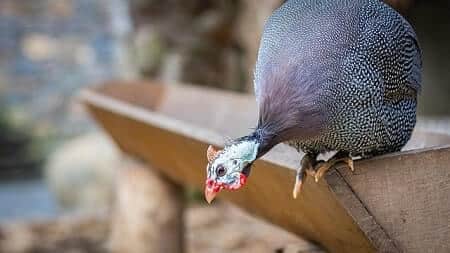Guinea fowl eggs are a creamy white to light brown color. They tend to have brown spots or speckles, which can be light to dark in color. They look different from chicken eggs in a number of ways.
Table of Contents
What Does a Guinea Egg Look Like?
The best way to understand exactly what Guinea fowl’s egg looks like is by watching this video:
You can see a Guinea egg side-by-side with regular chicken eggs. They are noticeably lighter in color than brown chicken eggs, smaller, a little pointer at the top, and you can’t tell from the video but the shell is a lot stronger.
If you keep both chickens and Guinea fowl in your backyard you’ll notice the difference between the two, that’s for sure.
Even if you have pullets that have just started laying small eggs, a Guinea egg is a different shape and much stronger.
Related - Keeping Guinea fowl and chickens together.
Can You Eat Guinea Eggs?
Yes, you can eat Guinea eggs - they’re just not as commonly available as chicken eggs.
There are no supermarkets or even farmer’s markets near me that sell Guinea eggs. So, I know how difficult it is to get hold of them.
I hope you can find some locally to try if you’re not raising Guinea though. They don’t taste much different from chicken eggs, but if you’re anything like me you like to try anything once.
Due to being smaller, you’ll probably need twice as many. The only real difference when cooking them is how hard they are to crack open, be prepared to use some force.
Why Aren't Guinea Eggs Readily Available?
As with most consumables, it mostly comes down to supply and demand. As well as what other products are available and how much they cost.
The simple facts are that chickens lay a lot more eggs. Their eggs are also bigger, and less expensive to produce.
That’s why the shelves at your local stores are full of chicken eggs and you’ll rarely see a Guinea egg.
For example, ResearchGate carried out a study to see how many eggs 39 Guinea hens would lay over a nine-month period.
They collected a total of 3,910 eggs. That works out at about 100 eggs per Guinea, which is around 11 eggs per month, per hen.
When you compare this to some of the most prolific egg-laying breeds of chickens, such as the Rhode Island Red, Leghorn, and Golden Comet that can lay around 300 eggs a year, it’s quite the difference.
Then consider they are about half the size, and it becomes very obvious that it’s way more expensive keeping Guineas for egg production.
If you’re lucky enough to have your own Guineas, enjoy those eggs!
Should You Raise Guinea for Their Eggs?

I’m a huge advocate for raising any backyard birds, so if you’re asking me I’d say yes.
Guinea are happier in numbers, so you’ll probably have 4-5 at least. That means you could expect between 400-500 eggs a year.
That should be enough for you and your family and a few spare for your friends and neighbors. I wouldn’t plan on starting up a business selling them though!
They are more commonly raised for their meat. I hear it’s delicious, but to be honest I haven’t tried Guinea meat so I can’t comment on the taste.
There are more than enough other reasons to keep Guinea than just eggs though. Just check out some of the other articles in the Guinea Fowl section of the blog.
Related - A look at Guinea eggs vs chicken eggs: Differences Explained.
In Summary - What Color Are Guinea Eggs?
There you have it, you know now that Guinea eggs are light brown or a creamy white color and smaller than chicken eggs.
They taste the same, at least to me. I’ve heard some people describe them as being richer and gamier than chicken eggs, but that’s probably more so down to the diet of the bird that laid it.
Resources
Guinea egg production - ResearchGate.net
Image credits - Header Image by hbieser, inbody Guinea image by Charles Davis from Pixabay




